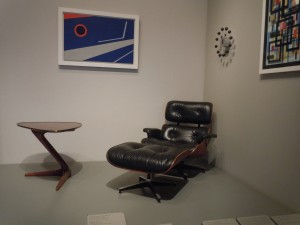 I find a lot of what I do involves boiling down complex, nuanced ideas into smaller steps or sound bites. Like the Eames chair and table to the right, you can accomplish a lot with really simple but innovative design.
I find a lot of what I do involves boiling down complex, nuanced ideas into smaller steps or sound bites. Like the Eames chair and table to the right, you can accomplish a lot with really simple but innovative design.
Currently, I’m in the process of editing my ongoing book project with Jenifer Fox. We’re taking months of work and cutting out the fat, getting down to the basics, and making a complex topic ultimately more useful and understandable to those who pick up our work. This process of narrowing down, making things more direct and useful isn’t always easy. I worry that in the process, we are leaving out useful advice, or things we’ve learned along the way.
But I’m also realizing that much like the “great books” the book itself is often a starting point for a conversation, not the whole thing. As my Jewish friends know, the Torah is great, but the commentaries and divining the meanings and applications have gone on for centuries. Sooner or later, you have to decide that the text is meant to be a starting point, but the interesting stuff comes afterwards, in the application of the ideas or suggestions into practice, and what happens when theory and prediction meet the real world.
Chris Penn did a great job today summarizing Accomplishment into Means, Motive and Opportunity. (A post well worth your time, so please go give it a read.) This is a great example of boiling down what it takes to get something done into an easy to remember framework that’s portable to almost any situation. We love getting everything down to fundamental mantras and lists- it makes information compact and portable. But like anything else, simplicity and ease of use are great design features- but the payoff is in the end utility. This great chair is awesome, but the one in the museum is fundamentally useless to me as anything other than an object d’art- it’s only useful if it’s in my office, or I do something with this idea of chair and carry it forward into another realm.
One of the things I love about the Apple products I use is they are all about simplicity and making it easy to get work done. The keyboard, the touchscreen, the mouse, the monitor- whatever- are as simple and clutter-free as possible, providing the minimal number of hurdles and distractions between you and your goals. The more straight-forward, the less complicated, the easier it is to get to the heart of the matter. And like the book editing, or the Eames chair, or the “top three things to eat for breakfast” list, simple makes interactions easy. But the really interesting stuff happens under the hood, when you understand the deeper levels of what went into the design, why it works well, and the active choices that went into the simplification.
Simple and straight forward is awesome. It takes lots of work. But for those of you skimming the surface of simple and finding that it seems “too easy” or you aren’t getting the results you want, remember that you also have to deep dive for more nuanced information at your own option. The simple are merely icons for the more interesting and useful stuff underneath, and it’s up to you to learn and discover more.
